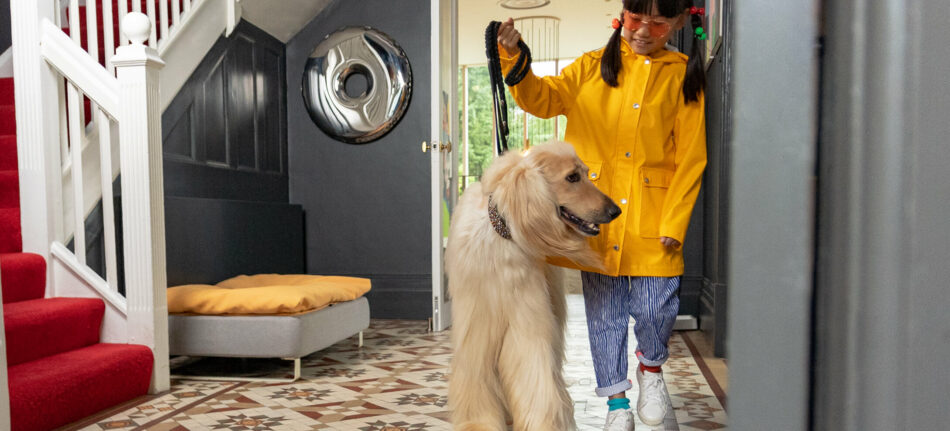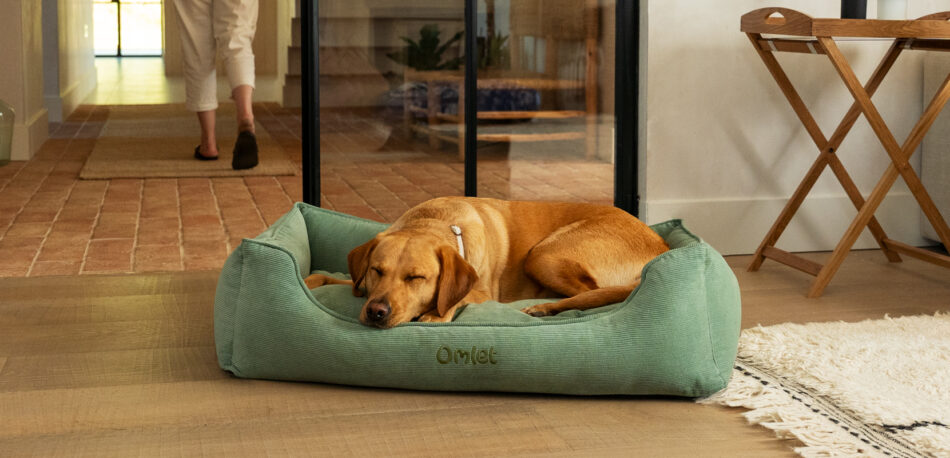Winter tips for you and your dog
In need of some winter tips for you and your dog? All dog owners differ on how they weather this season. Do you dash out and back in as quickly as possible, leading to frequent trips throughout the day? Or do you add layer upon layer to stay warm during the fewer, but longer, treks out into the cold? Whether you and your dog thrive in the chilly air or dread the inevitable outings — here’s how to make winter easier on you and your canine companion.
What’s winter with your dog like?
Not all dogs and their owners will experience frigid weather during the winter. Snow and ice may pose the biggest hurdle for some dog families, while the earlier nights and dark walks may be the biggest challenge for others. No matter where you live, here are some tips to keep in mind for a safer, more enjoyable winter for you and your dog.
Safety first
It’s important to prioritise you and your dog’s safety during the winter. Here are some common safety concerns for dog owners during the winter:
- Freezing weather can cause hypothermia in humans and dogs. This includes wind chill temperatures when the ambient air may not be below freezing, but wind gusts or humidity levels make it feel much colder.
- Walks in the dark are sometimes inevitable, but should be avoided when possible. If you must walk your dog after dusk, be sure to outfit yourself and your dog with reflective elements, and stick to low-traffic routes.
- De-icers and antifreeze are used in abundance during the winter. Don’t let your dog lick any surfaces that may have these compounds on them, and wash their paws immediately after a walk to remove any potentially harmful substances.
Easing your dog into winter is one of the best ways to avoid cold weather mishaps. Most dogs that spend the majority of their time indoors are unlikely to experience winter emergencies. But, as always, it’s a good idea to have your veterinarian’s number saved for any questions or concerns.
Business in the backyard
If you have a fenced garden, it may not be necessary to go out with your dog for them to do their business. But puppies, or dogs with high-energy will need their human companion outside with them for praise and playtime. If your backyard is dog-friendly, here are some tips:
- Keep a clean towel by the door for quick cleanups when your dog is ready to come inside. Wet coats and muddy paws can be remedied quickly when you intercept your pup at the door.
- Set a timer on your smart device if it’s really cold as a reminder to check and see if your dog is done. This is especially true if your dog doesn’t scratch or bark at the door to come back inside.
- Periodically check your backyard for winter hazards like large icicles hanging from the roof or broken tree limbs that could potentially fall and harm your dog.
For backyard playtime in the snow, choose an owner-led activity like fetch or tug-of-war to get both you and your dog’s blood pumping. This will also give you a chance to assess how cold your dog may be in the event they become too preoccupied with the game to recognise the need to head inside.
When walks are necessary
Walking your dog in the winter can pose several challenges. Some owners enjoy a brisk walk in the crisp air, while others may dread the deed. But if you don’t have access to a fenced yard, or if your dog is the type that requires at least a daily walk around the block, here are some things you can do make winter walks more enjoyable:
- Invest in cold-weather gear, particularly those that appeal to you. Just like getting a new outfit for the gym to motivate your workouts, donning a new coat, hat, or scarf that you adore can make the trek outside a little less daunting.
- Bring some entertainment along in the form of an audiobook, podcast, or music to help pass the time. Bonus points for winter-themed or dog-related content.
- Be mindful of your mind — keep calm and positive (despite the cold) so your dog doesn’t pick up on negative emotions or get the feeling of being rushed. This can make them take longer to do their business, or make them anxious on the leash.
If temperatures are well below freezing, try to keep walks as brief as possible. Always keep your dog on a lead to prevent them from encountering hazards like frozen bodies of water or dangerous chemicals like antifreeze.
Does my dog need a coat?
Dog owners will often adorn their pets with winter coats or jackets. While these are often an expression of style, there are times when coats for dogs aren’t just meant to be a fashion statement. Some dogs need an additional layer of protection against the cold during their outdoor excursions. These include:
- Dogs with short hair may need additional layers when venturing outside. As a general rule for these dogs: if it’s too cold for you to go without a winter coat, it’s too cold for them.
- Older dogs and puppies, as they can’t regulate their body temperature as well as dogs in their prime.
- Cold, wet precipitation like sleet or rain can quickly chill humans and dogs alike and quickly escalate the risk of hypothermia.
Dog breeds with undercoats like Huskies or German Shepherds likely don’t need a coat. Their dense, dual-layers keep them well insulated against the cold. For dogs in need of a coat, choose a level of insulation appropriate for their activity and climate. Waterproof dog coats are a good option, as they keep your dog warm and protected from damp weather.
The post-cold nap
After any amount of time outside in the cold, your dog will be just as ready as you are to snuggle into something cosy. An Omlet dog bed is just what your dog needs after a chilly trip outside. Warm, supportive, and wipeable, these beds are perfect for post-adventure naps. And, with orthopedic cushioning, they’re ideal for aging or arthritic dogs. Add a dog bed topper for ultimate coziness, or a dog bed cover for even easier washing.
While your canine catches a nap, take this time to observe their pads. The dry winter air combined with the frozen ground can sometimes cause your dog’s pads to crack, which can lead to discomfort when walking. Apply a canine-safe balm or petroleum jelly to any affected pads to moisturize and prevent cracks from worsening.
When the weather outside is frightful
If the weather is too cold to go out for anything more than a quick potty break, you may need to get creative to avoid boredom in your dog. Here are some dos and don’ts to help weather the winter from an indoor standpoint:
Do:
- Invest in new interactive or chew toys to add into your dog’s rotation.
- Encourage playtime several times a day to exercise your pup’s mind and body.
- Try out new activities like making homemade dog treats, teaching your dog new tricks, or spending time grooming them.
Don’t:
- Rely on toys to be the sole source of entertainment and enrichment for your dog.
- Try to bust canine boredom with food and treats. Choose healthy, homemade recipes to offer in moderation, or use their regular kibble as a reward during training sessions.
- Overgroom your dog by brushing out their undercoat or having them trimmed too short.
Omlet and your dog
Winter will be over before we know it, giving way to a sunnier, warmer spring. Until then, give your dog the most comfortable, support sleep of their life with a Bolster Bed, Topology Bed, Nest Bed, or Cushion Bed. With a size and color to fit every dog, home, and style, our dog beds will warm your dog’s body, and your heart, on even the coldest of days.
This entry was posted in Dogs


